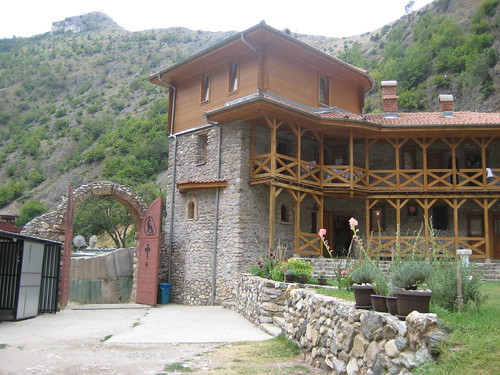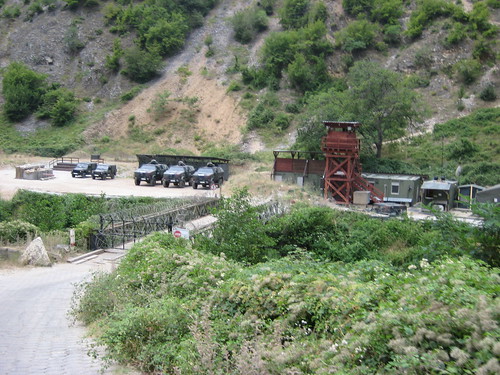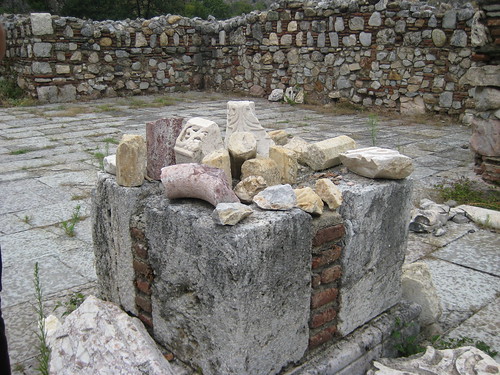
When you leave Prizren along the Bistrica River, after 2,5 km on the old road between Prizren an Skopje you meet the Holy Archangels Monastery (Манастир Светих Архангела) on the right. It was founded by Tsar Dusan and built between 1343 and 1352 on the place of the earlier church,and is parto of Visegrad fortress complex (the fortress is above on a mountain).
The monastery was looted and annihilated after the Ottomans arrived in 1455, and in 1615 it was rased to the ground, and its material was used for the construction of the Sinan Paša Mosque in Prizren. The entire complex was archeologically explored in 1927, and its remains were conserved after Second World War.
In the 1990's the reconstruction of Holy Archangels began. The necessary infrastructure was built and within the old walls a new residential quarter (konak) was built for the brotherhood of monks. A chapel was built inside the konak dedicated to Holy Bishop Nicholas of Žica. The first monks arrived in 1998 and the monastery since then has gained an important role in the spiritual life of the Serb people, especially in this area.


After the 1999 NATO bombing of Yugoslavia and retreat of the Yugoslav army forces, reconstructed objects were burned and looted in June 1999, by the members of KLA, after the KFOR arrival.
But the reconstruction was interrupted by the war, the 1999 NATO bombing of Yugoslavia and retreat of the Yugoslav army forces in this region, which has not spared the brotherhood of the Holy Archangels. In June 1999 a monk from the monastery, Fr. Chariton, was abducted. Immediately afterwards, a dozen of monks, together with the majority of the Serbs from this region, left the monastery. The headless body of Fr. Chariton was found in mid 2000 and buried in Crna Reka Monastery. After the arrival of KFOR the brethren gradually returned to the monastery.

During the 2004 unrest in Kosovo, the monastery was burned and looted again by albanian terrorists though during that time it was "controlled" by the KFOR. It's not really understandable how this could happen...I let the conclusions up to your fantasy.
The entire monastery complex is under protection of the Republic of Serbia, as a Monument of Culture of Great Importance, and today in the monastery lives a brotherhood of eight monks that are under constant protection of the German KFOR. :-)


Today the life of the monastery unfolds in complete isolation and consists of everyday services and monastic duties. The woodcarving workshop produces miniature carved items which are very rare and have become well-known abroad. The tailoring workshop is also busy and the monks are learning to work with computers. Today the monastery has become a spiritual center gathering the remaining Serb Orthodox people from Prizren and Sredacka Župa.
ARCHITECTURE
Having inherited the rich building tradition of his predecessors, Dušan's demands with respect to the architecture and richness of the Monastery were great. He probably wanted the pious endowment in which his earthly remains were to be interred to be a symbol of the power and greatness of the state which he ruled.

In addition to the large Church of the Holy Archangels, residential quarters, library and other buildings, within the Monastery there was another, smaller church, the Chapel of St. Nicholas. In the Monastery Charter one can read that a separate building within the complex was designated as the infirmary. The monumental refectory was cross-shaped with an apse on the eastern side. A bridge across the Bistrica River connected the Monastery with Dušan's castle at Ribnik and the royal palace in Prizren.

Holy Archangels was a great imperial pious endowment, lavishly decorated with rich materials. Although the name and origin of the main architect are unknown, it is almost certain that a building of such harmonious proportion and shape and such exquisite workmanship could only have been the work of an architect who had fully mastered the experience of the architects of Constantinople architects in spatial exposition and wedded it to the Mediterranean, Romanesque-Gothic sensibility in the use of stone. In Holy Archangels we appear to have the full flowering of the long-awaited synthesis of religious art forms of the European East and West which matured in the Raška school, on the one hand, and in the monuments of Kosovo and Macedonia, on the other.

Here to download is a very informative file from the European Commission.

No comments:
Post a Comment